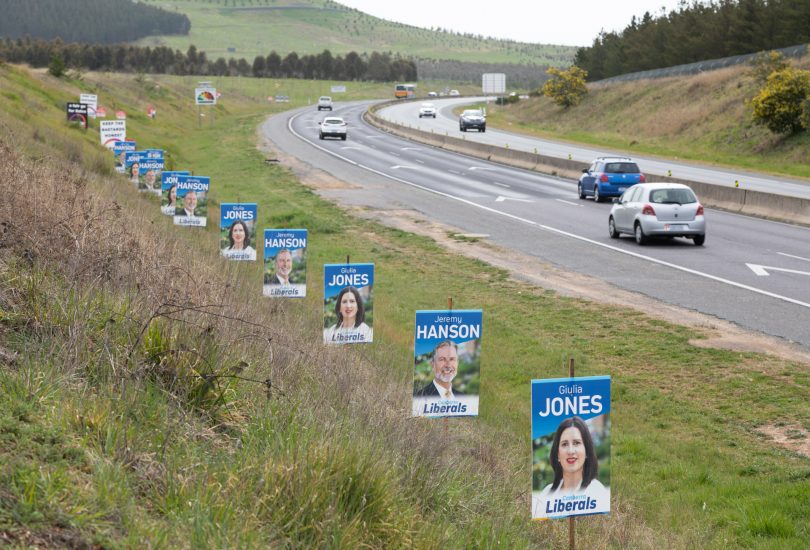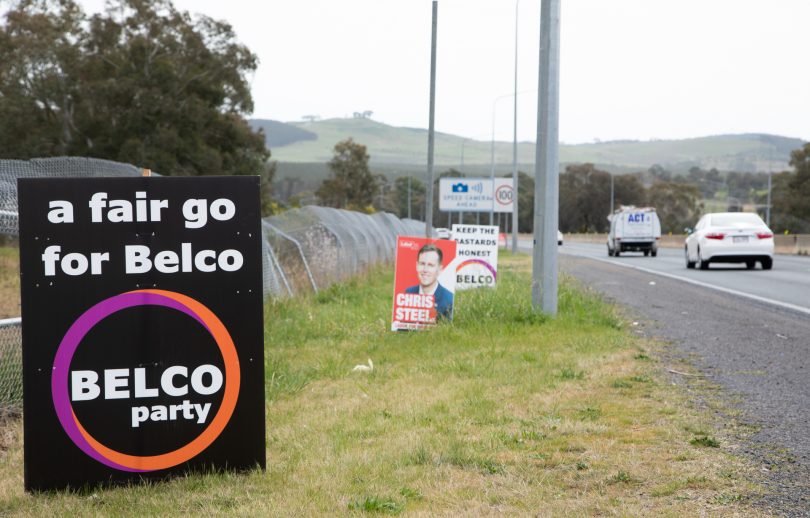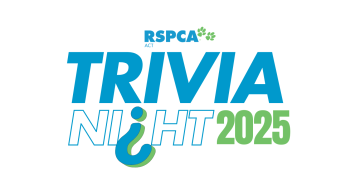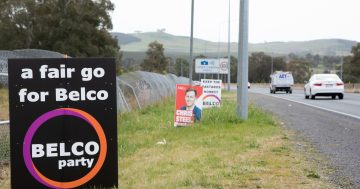
Election corflutes on the Tuggeranong Parkway this week. Photos: Michelle Kroll.
In case you hadn’t noticed, it’s less than six weeks until the ACT election and corflutes are already creating their own path towards the polls on 17 October.
Just as they are being put up, some have been strategically knocked down along the Tuggeranong Parkway while Transport Canberra and City Services (TCCS) rangers have removed 37 election corflutes that were considered a hazard along the light rail corridor.
A TCCS spokesperson told Region Media that the corflutes must comply with the requirements of the Public Unleased Land (Movable Signs) Code of Practice 2013 or they will be removed.
“Licensing and compliance officers removed 37 signs along the light rail corridor on Flemington Road on Monday (7 September),” the spokesperson said.
“Moveable signs cannot be placed within the light rail and associated road corridors network, which includes the stations and layover areas and adjacent road verges.”
Under current laws, there is no limit to the number of roadside electoral corflutes that can be used in the ACT and thousands of the plastic roadside billboards have already been pegged into the landscape.
There is also no law against vehicles (including trailers) having election material affixed to them.
In what has become a call to arms, the ACT Greens again called for election corflutes to be banned.
The Greens’ campaign spokesperson for democracy, Emma Davidson, labelled them “a huge turn off for the community and a huge waste of plastic”.
“It’s well past time to get rid of these annoying electoral signs,” Ms Davidson said.
“Overnight, they’ve popped up everywhere – and no surprise, given there is currently no limit on how many signs can be displayed in any one area.
“Roadsign corflutes indicate nothing about the level of public support for a candidate, just how much money a party has.”

Election corflutes on the Tuggeranong Parkway.
The Greens say they are displaying signs in the front yards of individual households who chose to display them. They are made from 100 per cent recycled material and can be recycled in a person’s yellow bin.
“Once the election is over, we can only assume that most of these end up going straight into landfill. What an utter waste,” Ms Davidson said.
The Greens also say there are a number of uses for used election signage, including as house insulation, building chook sheds, as tree guards, habitat for local wombats or painting over them for protest signs.
The ACT Electoral Commission’s report on the 2016 ACT election also noted “a relatively widespread degree of dissatisfaction with the proliferation of campaign signs across Canberra’s main roads and suburban streets”, but stopped short of recommending that the roadside electoral signs be banned entirely.
Signs cannot be placed at roundabouts, median strips, within 20 metres of traffic lights, on residential nature strips, or within 20 metres of the corner of an intersection. They must also be at least 1.2 metres back from the street kerb.
Signs must be self-standing and stable in windy conditions. If a sign falls down, it may also be removed.
They cannot be attached to or obstruct government property such as bridges, overpasses, trees, traffic lights, street lights and traffic control boxes. They must not obstruct or restrict access to walkways, bike paths, nature strips, emergency vehicle access routes, fire hydrants, above-ground and in-ground services. They also must not impede maintenance activities.
Signs are also banned on Northbourne Avenue, the Barton Highway, Federal Highway, Adelaide Avenue, Morshead Drive, Kings Avenue and Commonwealth Avenue.
A person who places a movable sign in a public place must also have a current public liability insurance policy with at least a $10 million liability limit.
According to the act, all signs must be removed within 48 hours of polling booths closing.
You can contact Access Canberra on 13 22 81 to report a sign in breach of the code.

















